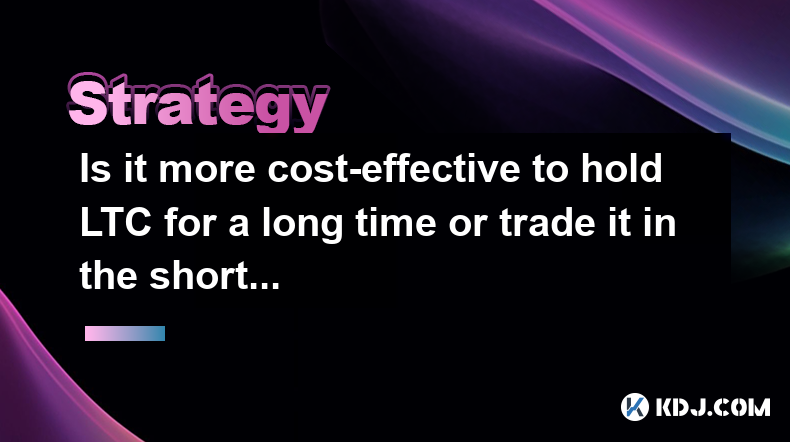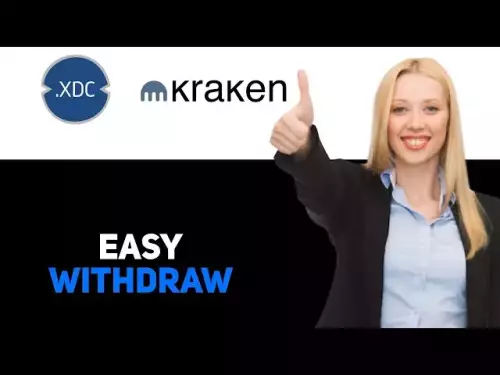-
 bitcoin
bitcoin $114684.631706 USD
-0.87% -
 ethereum
ethereum $4228.677447 USD
1.58% -
 bnb
bnb $1294.880693 USD
-1.16% -
 tether
tether $1.000819 USD
-0.02% -
 xrp
xrp $2.605138 USD
2.79% -
 solana
solana $209.908690 USD
5.89% -
 usd-coin
usd-coin $0.999903 USD
-0.03% -
 dogecoin
dogecoin $0.213423 USD
2.93% -
 tron
tron $0.322721 USD
-0.10% -
 cardano
cardano $0.727247 USD
3.66% -
 hyperliquid
hyperliquid $42.339456 USD
6.05% -
 chainlink
chainlink $19.910811 USD
5.16% -
 ethena-usde
ethena-usde $1.000557 USD
0.00% -
 stellar
stellar $0.349734 USD
2.69% -
 bitcoin-cash
bitcoin-cash $543.848687 USD
-0.21%
Is it more cost-effective to hold LTC for a long time or trade it in the short term? What are the advantages and disadvantages of each?
Holding LTC long-term can save on fees and potentially yield significant gains, while short-term trading offers quick profits but with higher risk and costs.
Apr 30, 2025 at 12:29 am

Is it more cost-effective to hold LTC for a long time or trade it in the short term? What are the advantages and disadvantages of each?
The cryptocurrency market offers a variety of strategies for investors, and Litecoin (LTC) is no exception. When considering whether to hold LTC for the long term or trade it in the short term, it's essential to weigh the potential benefits and drawbacks of each approach. This article will delve into the cost-effectiveness of both strategies, exploring their advantages and disadvantages in detail.
Long-Term Holding of LTC
Long-term holding, often referred to as 'HODLing,' involves buying LTC and keeping it in your wallet for an extended period, typically months or years. This strategy is based on the belief that the value of LTC will increase over time.
Advantages of Long-Term Holding
Potential for Significant Gains: Historically, cryptocurrencies like LTC have shown the potential for substantial growth over the long term. Investors who bought LTC early and held onto it have seen significant returns.
Reduced Stress and Time Commitment: Long-term holding requires less active management compared to short-term trading. This can be less stressful and time-consuming, making it suitable for investors who prefer a more passive approach.
Lower Transaction Costs: Since long-term holding involves fewer transactions, investors can save on trading fees and other costs associated with frequent buying and selling.
Disadvantages of Long-Term Holding
Opportunity Cost: By holding onto LTC for an extended period, investors may miss out on opportunities to profit from short-term price fluctuations.
Market Volatility: The cryptocurrency market is highly volatile, and holding LTC long-term exposes investors to the risk of significant price drops.
Liquidity Concerns: If an investor needs to access their funds quickly, holding LTC long-term could pose liquidity issues, especially if the market is down.
Short-Term Trading of LTC
Short-term trading involves buying and selling LTC over shorter periods, often within days or even hours. This strategy aims to capitalize on the frequent price movements in the cryptocurrency market.
Advantages of Short-Term Trading
Quick Profits: Short-term trading allows investors to potentially make quick profits by taking advantage of the market's volatility.
Flexibility: Traders can adjust their strategies quickly in response to market changes, providing more control over their investments.
Learning Opportunities: Engaging in short-term trading can help traders gain a deeper understanding of market dynamics and improve their trading skills.
Disadvantages of Short-Term Trading
Higher Risk: The volatility that can lead to quick profits can also result in significant losses. Short-term trading carries a higher risk compared to long-term holding.
Increased Stress and Time Commitment: Short-term trading requires constant monitoring of the market and quick decision-making, which can be stressful and time-consuming.
Higher Transaction Costs: Frequent buying and selling leads to higher transaction fees and other costs, which can eat into profits.
Cost-Effectiveness Comparison
When evaluating the cost-effectiveness of holding LTC long-term versus trading it short-term, several factors come into play. The cost-effectiveness of each strategy depends on an investor's goals, risk tolerance, and time commitment.
Long-Term Holding Cost-Effectiveness
Cost Savings: As mentioned, long-term holding can save on transaction fees, making it more cost-effective in terms of direct costs.
Potential for Higher Returns: If LTC's value increases significantly over time, long-term holding can lead to substantial returns, potentially outweighing the opportunity costs of not trading.
Tax Considerations: In some jurisdictions, holding assets for longer periods may qualify for more favorable tax treatment, such as lower capital gains tax rates.
Short-Term Trading Cost-Effectiveness
Profit Potential: Short-term trading can generate profits quickly, which can be reinvested or used to cover costs.
Risk vs. Reward: The potential for quick profits must be weighed against the higher risk and costs associated with frequent trading.
Trading Tools and Platforms: The use of advanced trading tools and platforms can help mitigate some of the costs and risks, but these tools come with their own expenses.
Factors to Consider in Your Decision
Choosing between long-term holding and short-term trading of LTC depends on several personal and market-related factors. Here are some key considerations:
Risk Tolerance
Risk tolerance is a crucial factor. Long-term holding may be more suitable for those with a lower risk tolerance, as it involves less active management and potentially lower risk of significant losses.
Short-term trading may appeal to those with a higher risk tolerance who are willing to take on more risk for the potential of quick profits.
Time Commitment
Consider how much time you can dedicate to managing your investments. Long-term holding requires minimal time, making it ideal for those with busy schedules.
Short-term trading demands significant time and attention, which may not be feasible for everyone.
Investment Goals
Your investment goals will influence your strategy. If your goal is to build wealth over time, long-term holding might be more aligned with your objectives.
If you're looking to generate income or capitalize on market volatility, short-term trading could be more appropriate.
Market Analysis
Keeping an eye on market trends and LTC's performance can help inform your decision. If LTC shows strong long-term growth potential, holding might be more beneficial.
If the market is experiencing significant short-term fluctuations, trading could offer more opportunities for profit.
Frequently Asked Questions
Q1: Can I combine both long-term holding and short-term trading strategies with LTC?Yes, it is possible to combine both strategies. Some investors allocate a portion of their LTC for long-term holding while using another portion for short-term trading. This approach allows them to benefit from potential long-term growth while also taking advantage of short-term market movements.
Q2: How do I determine the right amount of LTC to hold or trade?Determining the right amount depends on your financial situation, risk tolerance, and investment goals. A common approach is to allocate a percentage of your portfolio to LTC based on your overall investment strategy. For example, you might decide to hold 70% of your LTC long-term and use 30% for short-term trading.
Q3: What tools can help me with short-term trading of LTC?Several tools can assist with short-term trading, including trading platforms like Binance or Coinbase Pro, which offer real-time data and advanced charting tools. Additionally, using trading bots or algorithmic trading software can help automate some of the trading processes and potentially improve efficiency.
Q4: How can I minimize the risks associated with short-term trading of LTC?To minimize risks, consider the following strategies:
- Set stop-loss orders to limit potential losses.
- Diversify your trading portfolio to spread risk across different assets.
- Use technical analysis to make more informed trading decisions.
- Stay updated with market news and trends to anticipate potential price movements.
Disclaimer:info@kdj.com
The information provided is not trading advice. kdj.com does not assume any responsibility for any investments made based on the information provided in this article. Cryptocurrencies are highly volatile and it is highly recommended that you invest with caution after thorough research!
If you believe that the content used on this website infringes your copyright, please contact us immediately (info@kdj.com) and we will delete it promptly.
- XRP Price Prediction: Weekend Rollercoaster or Rally?
- 2025-10-12 08:45:16
- Bittensor (TAO): Super Bullish Signals Point to Potential 2x Rally
- 2025-10-11 10:25:12
- Silver Price Correction: Navigating the Dip & Identifying Key SEO Keywords
- 2025-10-11 10:25:12
- Decoding Crypto Trends: Bittensor's Bull Run, Cardano's Dip, and LivLive's Presale Buzz in 'Uptober 2025'
- 2025-10-12 08:45:16
- MoonBull: The Crypto Meme Coin Promising 1000x Gains?
- 2025-10-11 10:30:01
- Crypto Payroll Revolution: Stablecoins, Altcoins, and the Future of Salary Payments
- 2025-10-11 10:30:01
Related knowledge

Practical parameter settings for a Bitcoin multi-timeframe moving average system
Sep 18,2025 at 10:54pm
Optimizing Timeframe Combinations for Bitcoin Trading1. Selecting appropriate timeframes is crucial when building a multi-timeframe moving average sys...

How can I filter out false breakouts in Dogecoin high-frequency trading?
Sep 22,2025 at 01:00am
Understanding False Breakouts in Dogecoin Trading1. A false breakout occurs when Dogecoin's price appears to move beyond a defined support or resistan...

Techniques for identifying tops and bottoms in the Bitcoin on-chain NVT model
Sep 20,2025 at 07:54pm
Understanding the NVT Model in Bitcoin Analysis1. The Network Value to Transactions (NVT) ratio is often described as the 'P/E ratio' of the cryptocur...

What does the surge in open interest in Bitcoincoin futures mean?
Sep 20,2025 at 11:18pm
Understanding the Surge in Dogecoin Futures Open Interest1. A surge in open interest within Dogecoin futures indicates a growing number of active cont...

How can I use the Ethereum USDT premium to gauge market sentiment?
Sep 18,2025 at 11:55pm
Understanding the Ethereum USDT Premium1. The Ethereum USDT premium refers to the price difference between USDT (Tether) traded on Ethereum-based plat...

What should I do if Ethereum staking yields decline?
Sep 20,2025 at 06:18am
Understanding the Causes Behind Declining Ethereum Staking Yields1. The Ethereum network transitioned to a proof-of-stake consensus mechanism with the...

Practical parameter settings for a Bitcoin multi-timeframe moving average system
Sep 18,2025 at 10:54pm
Optimizing Timeframe Combinations for Bitcoin Trading1. Selecting appropriate timeframes is crucial when building a multi-timeframe moving average sys...

How can I filter out false breakouts in Dogecoin high-frequency trading?
Sep 22,2025 at 01:00am
Understanding False Breakouts in Dogecoin Trading1. A false breakout occurs when Dogecoin's price appears to move beyond a defined support or resistan...

Techniques for identifying tops and bottoms in the Bitcoin on-chain NVT model
Sep 20,2025 at 07:54pm
Understanding the NVT Model in Bitcoin Analysis1. The Network Value to Transactions (NVT) ratio is often described as the 'P/E ratio' of the cryptocur...

What does the surge in open interest in Bitcoincoin futures mean?
Sep 20,2025 at 11:18pm
Understanding the Surge in Dogecoin Futures Open Interest1. A surge in open interest within Dogecoin futures indicates a growing number of active cont...

How can I use the Ethereum USDT premium to gauge market sentiment?
Sep 18,2025 at 11:55pm
Understanding the Ethereum USDT Premium1. The Ethereum USDT premium refers to the price difference between USDT (Tether) traded on Ethereum-based plat...

What should I do if Ethereum staking yields decline?
Sep 20,2025 at 06:18am
Understanding the Causes Behind Declining Ethereum Staking Yields1. The Ethereum network transitioned to a proof-of-stake consensus mechanism with the...
See all articles

























![[4K 60fps] Prisma by novichokk (1 Coin) [4K 60fps] Prisma by novichokk (1 Coin)](/uploads/2025/10/14/cryptocurrencies-news/videos/k-fps-prisma-novichokk-coin/68ee49804ba00_image_500_375.webp)
















































